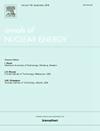A new network-level multi-objective optimization of the heat rejection system for megawatt space nuclear power systems
IF 1.9
3区 工程技术
Q1 NUCLEAR SCIENCE & TECHNOLOGY
引用次数: 0
Abstract
In Brayton, Stirling, or Rankine space nuclear systems, the Heat Rejection System (HJS) represents a critical component. The size and mass of the HJS significantly impact the overall performance of the space nuclear power system. This paper focuses on a three-wing HJS suitable for megawatt space nuclear power systems. The flow calculation model was coupled with the thermal radiation model to form the HJS calculation model, which was validated with an average error of 0.28 %. A novel network-level optimization method is proposed to optimize the mass density, pressure loss, and outlet temperature of the HJS by using flow connectivity and direction between different radiant units within the wings as independent variables. Optimal solutions for each loss function indicate that the outlet temperature has decreased from 390.70 K to 390.33 K, loop pressure loss has been reduced from 365 kPa to 361.38 kPa, and the mass density of the HJS has been reduced from 3.58 kg/m2 to 3.33 kg/m2. A simplified calculation method for the pre-design process of the HJS within the overall Space Nuclear Power System has been proposed and verified. This research provides valuable insights into the design of the HJS in megawatt-class space nuclear power systems.
兆瓦级空间核动力系统散热系统的一种新的网络级多目标优化
在布雷顿、斯特林或兰金空间核系统中,散热系统(HJS)是一个关键部件。HJS的大小和质量对空间核动力系统的整体性能有重要影响。本文研究了一种适用于兆瓦级空间核动力系统的三翼HJS。将流动计算模型与热辐射模型耦合,形成HJS计算模型,平均误差为0.28%。提出了一种新的网络级优化方法,以机翼内不同辐射单元之间的流动连通性和方向为自变量,对HJS的质量密度、压力损失和出口温度进行优化。各损失函数的最优解表明,出口温度从390.70 K降低到390.33 K,回路压力损失从365 kPa降低到361.38 kPa, HJS的质量密度从3.58 kg/m2降低到3.33 kg/m2。提出并验证了空间核动力总体系统中HJS预设计过程的简化计算方法。这项研究为兆瓦级空间核动力系统中HJS的设计提供了有价值的见解。
本文章由计算机程序翻译,如有差异,请以英文原文为准。
求助全文
约1分钟内获得全文
求助全文
来源期刊

Annals of Nuclear Energy
工程技术-核科学技术
CiteScore
4.30
自引率
21.10%
发文量
632
审稿时长
7.3 months
期刊介绍:
Annals of Nuclear Energy provides an international medium for the communication of original research, ideas and developments in all areas of the field of nuclear energy science and technology. Its scope embraces nuclear fuel reserves, fuel cycles and cost, materials, processing, system and component technology (fission only), design and optimization, direct conversion of nuclear energy sources, environmental control, reactor physics, heat transfer and fluid dynamics, structural analysis, fuel management, future developments, nuclear fuel and safety, nuclear aerosol, neutron physics, computer technology (both software and hardware), risk assessment, radioactive waste disposal and reactor thermal hydraulics. Papers submitted to Annals need to demonstrate a clear link to nuclear power generation/nuclear engineering. Papers which deal with pure nuclear physics, pure health physics, imaging, or attenuation and shielding properties of concretes and various geological materials are not within the scope of the journal. Also, papers that deal with policy or economics are not within the scope of the journal.
 求助内容:
求助内容: 应助结果提醒方式:
应助结果提醒方式:


